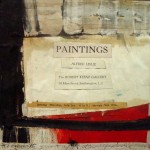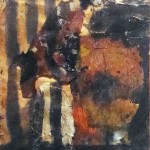Biography
Alfred Leslie (born 1927)
Born in New York City in 1927, Leslie began as an Abstract Expressionist painter, but in the 1960s moved to an intense, large-scale realism. He studied at New York University in 1956-57 with Tony Smith, Hale Woodruff, John McPherson and William Baziotes. Unlike most artists who spend years struggling to establish themselves, Leslie quickly gained a reputation as a second generation Abstract Expressionist. When he made his transition to realism, he was as easily recognized in that genre.
Geometric abstraction and collaged realistic elements were sandwiched between Leslie’s initial Abstract Expressionism and the ultimate realism of his artistic evolution. The process was completed in the course of only two or three years in the mid-1960s. All of Leslie’s paintings, whether abstract or realistic have tended toward monumental size. His portraits may be as large as nine feet high, and are painted with a metallic hardness of surface rather than the softness of flesh.
In the 1970s the artist returned to realism and sought to link timeless spiritual beliefs and past artistic tradition with the present in the creation of a contemporary context for biblical subject matter and the themes and compositions of Caravaggio.
Alfred Leslie’s paintings are in the Albright-Knox Art Gallery, Buffalo, New York; Hirshhorn Museum and Sculpture Garden, Washington, D.C.; Kuntshalle, Basel, Switzerland; Minneapolis Institute of Arts, Minnesota; Museu de Arte Moderna, Sao Paulo, Brazil; Stedelijk Museum, Amsterdam, The Netherlands; and the Museum of Modern Art and Whitney Museum of American Art, New York City.

 Untitled
Untitled
 Untitled
Untitled